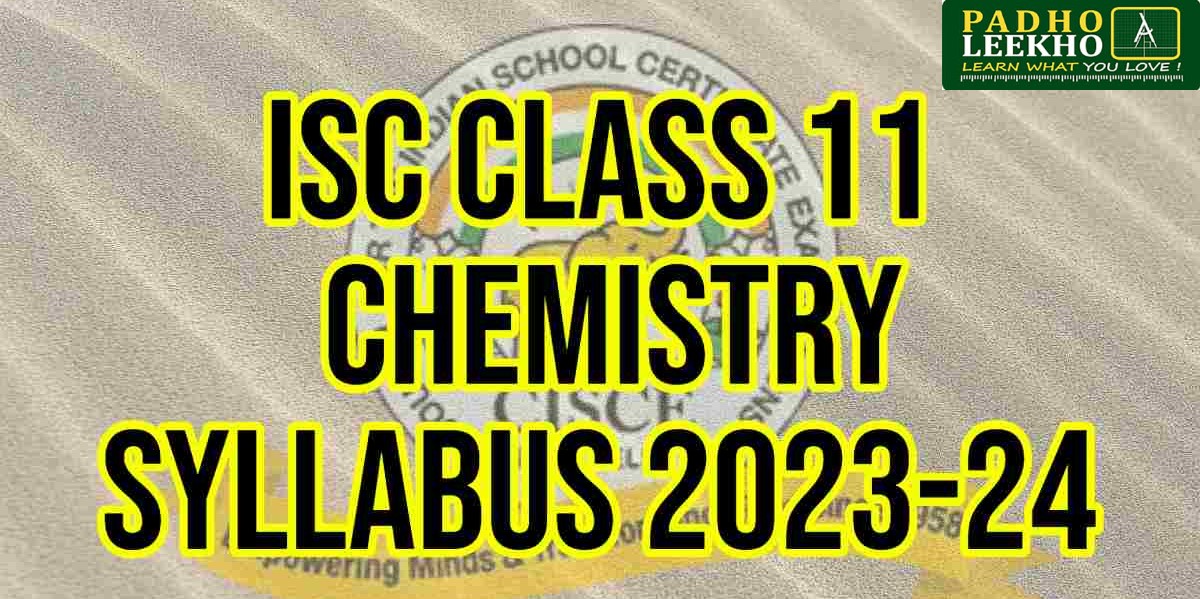About ISC (ICSE) Board
The board of ICSE (Indian Certificate of Secondary Education) is one of the most recognized and prestigious boards of education in India, managed by the CISCE (Council of Indian School Certificate Examination).
Unlock Exclusive Access To ICSE Class 11th PCM/PCMB Course Materials.
ISC (ICSE) Class 11th PCM/PCMB Courses By Padho Leekho
The council is a non-governmental education board in India that conducts the ICSE examination at the end of the 10th class and after the 10th standard, ICSE becomes ISC (Indian School Certificate) that examines the 12th class.
ISC Syllabus for Class 11 -PCM/PCMB
Class 11 plays an important role in defining the career course of a student.
Class 11 forms the basis of Class 12. It helps students by making their foundation strong for them.
Performing well in class 11 is quite important for students. To do so, students must have a thorough idea of the ISC class 11 syllabus.
ENROLL For Best ISC (ICSE) Class 11th Test Series
ISC is a government-recognized education board. Students who take admission into class 11 must be aware of their syllabus thoroughly. They should have an idea of the topics of each and every subject so that they can perform well in their exams.
ISC Class 11th Math Syllabus
Math is an essential subject as it builds concepts that appear in the competitive examination.
Class 11 ISC Math Syllabus has three sections with segregated marks and total weightage. The syllabus is designed for the students to make them understand brief concepts and theorems.
The Math Syllabus is divided in three sections- A, B & C
The topics under Section A :- Mathematical Reasoning, Algebra, Trigonometry, and Calculus.
The topics under Section B:- Vector and Coordinate Geometry in three Dimensions.
The topics under Section C:- Statistics and Average.
JOIN ISC (ICSE) Class 11th Courses at Affordable Prices
The below table list out the Class 11 Math Syllabus and the Units under each section:
| Sections | Units |
| Section A | 1. Sets and Functions |
| 2. Algebra | |
| 3. Coordinate Geometry | |
| 4. Calculus | |
| 5. Statistics and Probability | |
| Section B | 6. Conic Section |
| 7. Introduction to three-dimensional Geometry | |
| 8. Mathematical Reasoning | |
| Section C | 9. Statistics |
| 10. Correlation Analysis | |
| 11. Index Numbers and Moving Averages |
Details of ISC class 11 Math syllabus Section A:
1. Sets and Functions
- Sets
- Relations and Functions
- Trigonometry
2. Algebra
- Principle of Mathematical Induction
- Complex Numbers
- Quadratic Equations
- Permutations and Combinations
3. Coordinate Geometry
- Straight Lines
- Circles
4. Calculus
- Limits and Derivatives
5. Statistics and Probability
- Statistics
- Probability
Details of ISC class 11 Math syllabus Section B:
6.Conic Section
- Parabola
- Ellipse
- Hyperbola
7. Introduction to three-dimensional Geometry
8. Mathematical Reasoning
Details of ISC class 11 Math syllabus Section C:
9. Statistics
10. Correlation Analysis
11. Index Numbers and Moving Averages
The syllabus is segregated into three sections to enable students to acquire knowledge and understand the terms, concepts, symbols, and principles. In addition, the students will be able to develop their skills in computation, reading tables, charts, graphs etc.
This part in Geometry has a lot of importance as it is used in other branches of Math and Engineering.
ISC Class 11 Math Examination Paper Pattern
There are three sections in the examination, section A, B, and C. Section A is compulsory for all candidates, but students can choose to attempt questions from either Section B or Section C.
Section A: Section A is of 80 marks. Students are required to attempt all questions. In addition, they will have an internal/multiple choice for three questions of four marks each and two questions of six marks each.
Section B and Section C: Under Section B and Section C, students must attempt all questions from one Section. Internal/multiple choice is offered in two questions of four marks each. The total marks allotted under Section B and C together is 20.
ISC Class 11th Physics Syllabus
ISC Class 11 Physics Syllabus is a vital study resource for students preparing for the ISC Class 11 Physics board examination.
Students should know the entire Syllabus of each subject before they start preparing for their test.
A Brief Summary:
ISC Class 11 Physics textbook consists of 10 chapters as mentioned below:
Physical World and Measurements:
- Units & Measurements
- Measurement: units of measure, need for measurement, systems of units: fundamental and derived units in SI; measurement of length, mass and time and significant figures.
- Dimensional analysis and its implementation, the dimensional formula of physical quantities and constants.
Kinematics:
- Motion in a Plane(Axis).
- Scalar & vector quantity with samples. Position and displacement of vectors, general vectors and their notations; addition and subtraction of vectors, equality of vectors, unit vector, relative velocity, vector resolution in a plane, rectangular components, scalar and vector product of two vectors. Projectile motion and uniform circular motion.
Law of Motion:
- Newton’s first law of motion, the general concept of force, inertia and momentum, Newton’s second law of motion and impulse, and Newton’s third law of motion.
- Law of conservation of linear non-stop momentum and its applications.
- Equilibrium of concurrent forces. Friction: Laws of friction, Static and kinetic friction, rolling friction and lubrication.
- Dynamics of uniform circular motion: Centripetal(Outward) force, Examples of circular motion (vehicle on a level circular road, vehicle on a banked road).
Work, Power and Energy:
- Work done by a constant and variable force, work-energy theorem, power and kinetic energy.
- The potential energy of a spring, conservative force and mechanical energy (kinetic & potential energy); Conservative and non-conservative forces of energy.
The motion of system of particles & Rigid (Stiff) Body:
- The idea of Centre of mass – the Centre of mass or a two-particle system, Centre of mass motion and momentum conservation. Centre of mass of a rigid body and uniform rod.
- Moment of a force, laws of conservation of angular momentum and its applications, torque and angular momentum.
- Balancing of rigid bodies, their rotation and their equations of rotational motion, comparative study of linear and rotational motions.
- Statement of parallel axes and perpendicular axes theorems and their applications. Moment of inertia, the radius of gyration, & moments of inertia for simple geometrical objects (no derivation).
Gravitation:
- Kepler’s laws of planetary motion and its universal law of gravity. Acceleration due to gravitational force (g) and its variation with altitude, latitude and depth.
- Gravitational potential and its energy, escape velocity, orbital velocity of a satellite and Geo-stationary satellites.
Properties of Bulk Matter:
- Mechanical Properties of Solids: elastic behavior of solids, stress-strain relationship; Hooke’s law – young’s modulus, bulk modulus, shear modulus of rigidity, Poisson’s ratio and elastic energy.
- Mechanical properties of fluids: viscosity, Bernoulli’s theorem and its applications, Stokes’ law, terminal velocity, streamline and turbulent flow, critical velocity. Surface energy and its tension, angle of contact, and an excess of pressure across a curved area, application of surface tension.
HURRY!!! JOIN Today for the ISC (ICSE) Class 11th Test Series
Heat and Thermodynamics:
- Heat transfer – conduction, convection and radiation, thermal conductivity, qualitative ideas of Blackbody radiation, Wein’s displacement Law, Stefan’s law, and the Greenhouse effect
- Thermodynamics: Meaning of thermal balancing, the definition of temperature, work, heat and internal forces energy.
- The 1st law of thermodynamics, isothermal and adiabatic processes.
- The 2nd law of thermodynamics process includes reversible and irreversible process, heat engine & refrigerator.
Behavior of Perfect Gases and Kinetic Theory of Gases:
- Kinetic theory: equation of the perfect gas state, work done in compressing a gas. Kinetic theory of gases – assumptions, the concept of pressure.
Oscillations and Waves:
- Oscillations: Periodic motion, time period, frequency, displacement as a function of time, periodic functions. Simple harmonic motion (SHM) and its equation; phase; oscillations of a spring, restoring force and force constant; energy in SHM, Kinetic and potential energies; simple pendulum and derivation of expression for its time period.
- Waves: Wave motion, Transverse and longitudinal waves, displacement relation for a progressive wave, principle of superposition of waves, reflection of waves, standing waves in strings and organ pipes, fundamental mode and harmonics beats.
ISC Class 11 Physics Examination Pattern
ISC Physics Class 11 paper is divided into two parts:
Examination Paper I-Theory:
Students are supposed to answer all questions compulsorily but with an option of internal choice in two questions which carry 2 marks each, two questions of three marks each, and all the three questions of 5 marks each. As mentioned in the table below:
| Sl No. | Unit Name | Marks |
| 1 | Physical World and Measurement | 23 Marks |
| 2 | Kinematics | |
| 3 | Laws of Motion | |
| 4 | Work, Power and Energy | 17 Marks |
| 5 | The Motion of the System of Particles and Rigid Body | |
| 6 | Gravitation | |
| 7 | Properties of Bulk Matter | 20 Marks |
| 8 | Heat and Thermodynamics | |
| 9 | The Behavior of Perfect Gases and Kinetic | 10 Marks |
| 10 | Gravitation | |
| Total Marks | 70 Marks | |
Examination Paper II-Practical:
This will consist of 30 marks. The subdivision is mentioned below:
- Practical work duration is 3 hours – 15 marks.
- Project work weightage – 10 marks.
- Practical file weightage – 5 marks.
ISC Class 11th Chemistry Syllabus
There are a total of 17 units in ISC Class 11 Chemistry Syllabus. Students will learn about the basic concepts of chemistry, the structure of atoms, and chemical bonding in Class 11. The syllabus includes some crucial concepts such as environmental chemistry, organic chemistry, classification of elements, and molecular structure.
The below table offers the Class 11 Chemistry Syllabus and the Units under each section:
| Sections | Units |
| Section A | 1. Some Basic Concepts of Chemistry |
| 2. Atomic Structure | |
| 3. Periodic Table | |
| 4. Chemical Bonding | |
| 5. The Gaseous State | |
| 6. Surface Chemistry | |
| 7. Chemical Kinetics | |
| 8. Chemical Energetics | |
| Section B | 9. Study of Representative Elements: Group 1, 2, 13, 14, 15 |
| 10. Preparation, properties, and uses of Compounds of Groups 1, 2, 13, 14, 15 | |
| 11. Redox Reactions | |
| Section C | 12. Introduction to Organic Chemistry |
| 13. Isomerism | |
| 14. Types of Chemical Reactions and their Mechanisms | |
| 15. Aliphatic and Aromatic Hydrocarbons | |
| 16. Applications of Chemicals | |
| 17. Environmental Chemistry |
ISC Class 11 Chemistry Syllabus Section A:
1. Some Basic Concepts of Chemistry
- Precision and Accuracy
- Dimensional Analysis
- Atomic and Isotopic masses
- The concept of atoms having fixed properties in the laws of chemical combination.
- Relative molecular mass and mole.
- Chemical reactions on mass-mass, mass-volume, and volume-volume relationships.
2. Atomic Structure
- Fundamental particles such as Electrons, Protons, and Neutrons
- Rutherford’s nuclear model is based on the scattering experiment
- Bohr’s atomic model
- Hund’s rule of maximum multiplicity and nuclear structure.
3. Periodic Table
- Atomic number as the basis for classification of the elements in the Periodic Table.
- Periodicity of elements.
- The nuclear structure is the basis of periodicity. Ionization enthalpy, electron gain enthalpy, atomic volume, and electronegativity.
4. Chemical Bonding
- Electrovalent Bond
- Covalent Bond
5. The Gaseous State
- Kinetic theory, gas laws and equation of state
- Non-ideal behaviour of gases and van der Waal’s equation
- Dalton’s law, Avogadro’s constant, the mole, Graham’s law of diffusion.
6. Surface Chemistry
- Adsorption
- Colloidal state
- Chromatography
7. Chemical Kinetics
- Rate of a chemical reaction
- The basic idea of order
- Molecularity of a reaction
8. Chemical Energetics
- The first law of Thermodynamics
- The second law of thermodynamics
- Third law of thermodynamics
- Thermochemistry
ISC Class 11 Chemistry Syllabus Section B:
9. Study of Elements: Group 1, 2, 13, 14, 15
- Occurrence, Physical State, Electronic Configuration, Atomic and Ionic radii.
- Common oxidation state, IonisationIonization enthalpy, and Distinctive behaviour of the first member of each group.
- Nature of oxides, hydroxides, and chlorides.
10. Preparation and uses of Compounds of respective Groups 1, 2, 13, 14, 15
- Chemistry preparation, chemical properties, and benefits of the given compound.
- Biological importance of magnesium, sodium, calcium.
11. Redox Reactions
- Examples of Redox Reactions
- Oxidation numbers, rules, and simple calculations of oxidation state
- Balancing of redox reactions in the acidic and basic medium by oxidation number.
- ISC Class 11 Chemistry Syllabus Section C:
12. Introduction to Organic Chemistry
- Nature of a carbon atom and catenation
- Classification of an organic compound and homologous series
- Estimation of carbon, hydrogen, nitrogen, and halogens.
13. Isomerism
- Structural Isomerism: Definition, classification of isomerism.
- Stereo Isomerism: Definition of geometric isomerism.
14. Types of Chemical Reactions
- Substitution, addition, and elimination reactions
- Electrophiles and nucleophiles
- Inductive electrometric effects and hyperconjugation
- Free radicals and polar mechanisms.
15. Aliphatic and Aromatic Hydrocarbons
- Alkanes: General methods of preparation and properties of alkanes.
- Alkenes: Preparation and properties of alkenes.
- Alkynes: Methods of preparation and uses of ethyne.
- Benzene: Coal tar as an essential source of the aromatic compound; properties and uses of benzene; resonance mode of benzene
16. Applications of Chemicals
- Medicine: Antipyretics, analgesics, tranquillizers, antiseptics, disinfectants, and antacids.
- Soaps and Detergents: Classification, structure, properties of soap and detergent.
17. Environmental Chemistry
- Environmental pollution, atmospheric pollution, water pollution.
- Energy: Non-renewable and renewable energy such as diesel, petrol, LPG, and CNG. Future energy sources such as hydrogen, alcohol, fuel cells, and biofuels.
ISC Class 11th Chemistry Exam Pattern
One paper of three hours duration is divided into two parts.
Part 1 (20 Marks) is a compulsory section where the student has to attempt short answer questions. This section will test their knowledge, application, skills relating to elementary/fundamental aspects of chemistry.
Part 2 (50 Marks) is divided into three subsections A, B, and C. The students can answer two out of three questions in Section A (each carries ten marks). In Section B, they can attempt two out of three questions, each carrying five marks. Further, in Section C, two of three questions each carry ten marks. Thus, there are a total of six questions in part 2. It is essential to practice before the first-term exam. The student may refer to ISC Chemistry Class 11 Syllabus for more information.
ISC Class 11 Biology Syllabus
There are three sections in ISC Class 11 Biology Syllabus, including Section A, Section B, and Section C.
| Sections | Units |
| Section A | 1. Diversity of Life |
| Section B | 2. Plant Physiology |
| 3. Multicellularity: Structure and Functions of Plants and Animals | |
| 4. Units of Life | |
| Section C | 5. Organisms and Environment |
ISC Class 11 Biology Syllabus Section A:
1. Diversity of Life
- Taxonomy and phylogeny, three domains of life: binomial nomenclature.
- Five-kingdom classification: characteristics, salient features, and examples.
- Anatomy of different cockroach systems.
ISC Class 11 Biology Syllabus Section B:
2. Plant Physiology
- Mineral nutrition: macronutrients, micronutrients, criteria for the essentiality of elements, and nitrogen in plants.
- Plant growth, phases of development, measurement of plants.
- Photomorphogenesis in plants.
3. Multicellularity: Structure of Plants and Animals
- Plant Tissues: types of plant tissues, structure and functions of superficial tissues, types of vascular bundles.
- Animal Tissues: epithelial, connective, muscular, nervous tissues.
- Nutrition: Calorific value of carbohydrates, organs of the digestive system, digestive process, and disorder of the digestive system.
- Respiration: Organs of the respiratory system, pulmonary gas exchange, transport of respiratory gases. Disorders of the respiratory system.
- Circulation: Closed and open vascular systems, the structure of the human heart, coagulation of blood. Disorders of the Circulatory system.
- Excretion: Structure of nephron, the role of skin and lungs in excretion, kidney functions.
- Endocrine system: Mechanism of hormone action, the effect of hyposecretion, feedback mechanism.
- Nervous system: Central, automatic, and peripheral, the structure of the brain and spinal cord, transmission of nerve impulse.
- Locomotion: Structure of skeletal muscle, sliding filament theory of muscle contraction. Disorder of muscular and skeletal system.
4. Units of Life
- Biomolecules: Outline classification and functions of carbohydrates.
- Enzymes: General properties, classification, mechanism of enzyme action.
- Cell membranes: Facilitated diffusion, membrane transport, passive and active transport.
- Cell structure: structure and functions of nucleus, cell wall, vacuoles, and cell inclusions. Prokaryotic cell and eukaryotic cell- a comparison.
- Cellular respiration: aerobic and anaerobic fermentation, amphibolic pathway.
- Cell reproduction: cell cycle, mitosis, and meiosis.
ISC Class 11 Biology Syllabus Section C:
5. Organisms and Environment
- Ecosystem: biotic and abiotic components, biochemical cycles, ecological pyramids. Productivity and decomposition.
- Pollution: air, water, and soil pollution.
BEST Test Series for ISC (ICSE) Class 11th
ISC Class 11 Biology Paper Pattern
Part 1 (20 Marks) is a compulsory section, and students have to attempt short answer questions. This section will test the student’s knowledge, application, and skills relating to the fundamentals aspects of the biological concepts.
Part 2 (50 Marks) consists of three sections, including A, B, and C. The students can attempt two out of three questions in Section A (each carries five marks). Further, in Section B, they can attempt two out of three questions, each carrying ten marks. Lastly, in Section C, the students can attempt two out of three questions, each having ten marks. Thus, a total of 6 questions are required to answer in Part 2.





























